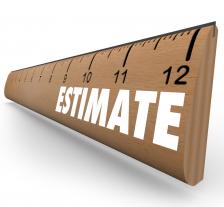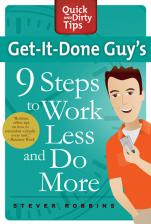Make Better Estimates Through Time Tracking
Intuitive estimates are almost always wrong. A little simple data tracking, however, and you’ll be estimating like a pro.

Sponsor: This episode of Get-It-Done Guy is brought to you by our friends at LessMeeting.com– Less Meeting improves meetings through set agendas, shareable notes and automated follow ups in one easy to use tool. Come prepared for your next meeting. For a free trial, go to LessMeeting.com and when you’re ready to buy, use code GETITDONE at checkout to get 10% off your team pack.
Every Do-It Day, someone always says “In the next hour, I plan to write 6 pages of my novel.” My heart sinks. Six pages in one hour? I could never do that; I’m a pathetic, miserable failure.
But then, at the next hourly check-in, the once-hopeful author calls in, full of despair. “I only got through a page and a half!” I say sympathetic words. Inside, however, joy! Happiness! Schadenfreude! Who’s the pathetic, miserable failure now, eh? Then I realize that when writing my book, I averaged at most one page per hour max. Their failure is better than my crowning achievement. Great. Now I suck again.
Actually, I don’t suck. Neither does my author friend. What sucks is human nature. Specifically, the Planning Fallacy. That’s a fancy word that means everyone underestimates how long it takes to do something. Psychologist Daniel Kahneman has proven it (and it took a lot more work to run the experiments than he thought it would).
When we underestimate, we don’t schedule enough time to complete a task and we schedule too many competing commitments. We get overloaded and grumpy towards everyone around us. You owe it to yourself, your polyamorous family units, and your pet chihuahua Spunky to learn how to estimate well.
Track What You Do
Your intuition won’t estimate, so let’s turn to the thing that gave us iPhones, velcro, and Twinkies: science. Science is great at understanding the world, especially when the world doesn’t fit our intuition.
Science starts with data and measurement, so let’s get measuring. Create a tracking grid for your activities, like the one in the episode How to Deal with a Boss who Gives Too Much Work. The first column is a wide column, where you’ll write the activity you’re tracking. Then have enough small columns to track 15-minute increments throughout your workday. One column for 8am to 8:15am, one for 8:15am to 8:30am, and so on. Click here for a printable PDF of a grid.
Now measure to find out how long something really takes. Enter the task on a blank row. For example, “write 5 pages of book.” Set a timer to go off every 15 minutes. When the timer goes off, put a check in the box corresponding to the time. When you finally finish, the row of checkmarks will tell you how long it actually took to finish the task.
Voila! Now you’re using science, and confronting the cold, hard truth that it doesn’t take 5 minutes to write 5 pages, it takes 5 hours.
Track Your Unmeasured Overhead
Your favorite web sites thrive off consumer engagement. In other words, hijacking your attention and deliberately seeking to ruin your productivity. They call it “targeted advertising.”
But there’s a trick. Remember when you wanted to make sure you used the word “omphaloskepsis” correctly? You looked it up in six different dictionaries. That wasn’t time spent writing, but it was time spent in a task so closely related that it’s likely to factor into future writing sessions.
Track these related tasks separately from your main task. Below “write 5 pages of book,” label a line “writing-related tasks.” When your fingers are actually on the keyboard, check the “write 5 pages” line. When you’re doing related tasks that aren’t actually writing, check off the “writing-related tasks” line.
Now you’ll have an idea of how long writing takes you, and how much of that time is actually spent doing the related activities we never remember in our intuitive estimates.
Track Unrelated Overhead
And then there’s the web. Remember when you visited that web site to look up “ompheloskepsis?” You spent 20 seconds reading the definition, then 20 minutes browsing “50 Reasons to Be Jealous of Billionaires’ Dogs.” It worked. In a jealous rage, you spent 15 more minutes posting a scathing indictment of doggy-owning billionaires on your Facebook page.
That isn’t task-related overhead at all; it’s plain old distraction. Your favorite internet sites thrive off consumer engagement. In other words, hijacking your attention and deliberately seeking to ruin your productivity. They call it “targeted advertising.”
Now you know how long typing takes you. You know how much of that was typing, how much was other writing-related tasks, and how much was distraction.
Use This Knowledge
Knowledge is power. You now have knowledge. Thus you have power. Use it wisely.
Use your data to estimate how long something will take. After writing 450,000 words of Get-it-Done Guy content, I know my writing speed is 400 words per hour without distractions. My heart says “I can write a book in a week!” My data says otherwise. With distractions? Let’s not even go there.

Use this data to understand your business. If you know how long things take, you can estimate the total capacity of your business. A coaching client who does marketing studies determined it takes one person 10 days to prepare a marketing study. The 6-person firm uses this knowledge. They know they can handle 6 simultaneous clients, max.
Don’t let your estimating make your life a living heck! Use a grid to track your time, including the tasks and interruptions you often forget. Soon you’ll be able to estimate like a pro.
Estimate ruler image courtesy of Shutterstock.
You May Also Like…






